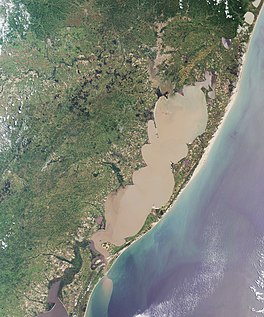
Back لاغوا دوس باتوس Arabic بحيره لاجوا دوس باتوس ARZ Patus gölü Azerbaijani Патус (возера) Byelorussian Патус BE-X-OLD Патус Bulgarian Lagoa dos Patos Breton Lagoa dos Patos Catalan Lagoa dos Patos (lanaw) CEB Lagoa dos Patos Czech
| Lagoa dos Patos | |
|---|---|
 Lagoa dos Patos from satellite | |
| Location | Brazil |
| Coordinates | 31°06′S 51°15′W / 31.100°S 51.250°W |
| Type | lagoon |
| Primary inflows | Jacuí-Guaíba and Camaquã River |
| Primary outflows | São Gonçalo Channel |
| Catchment area | 201,626 km2 (77,848 sq mi)[1] |
| Max. length | 180 miles (290 km) |
| Max. width | 44 miles (71 km) |
| Surface area | 10,100 km2 (3,900 sq mi)[2] to 10,360 km2 (4,000 sq mi)[1] |
| Average depth | 6 m (20 ft)[3] |
Lagoa dos Patos (Portuguese pronunciation: [laˈɡoɐ dus ˈpatus]; English: Ducks' Lagoon) is the largest lagoon in Brazil and the largest coastal lagoon in South America.[2] It is located in the state of Rio Grande do Sul, southern Brazil. It covers an area of 10,100 km2 (3,900 sq mi),[2] is 180 miles (290 km) long and has a maximum width of 44 miles (71 km).[4]
Lagoa dos Patos is separated from the Atlantic Ocean by a sandbar about 5 miles (8.0 km) wide. The Jacuí-Guaíba and Camaquã Rivers empty into it, while the navigable São Gonçalo Channel, which enters Lagoa dos Patos near the town of Pelotas, connects Lagoa dos Patos to Lagoa Mirim to the south.[2] The Rio Grande, at the south end of Lagoa dos Patos, forms the outlet to the Atlantic.[2]
This lagoon is evidently the remains of an ancient depression in the coastline shut in by sand bars built up by the combined action of wind and current. The shallow lagoon is located at sea level and its waters are affected by the tides, normally they are brackish only a short distance above the Rio Grande outlet,[2] but this can vary a lot. In droughts and favorable winds, sea water can be carried up to almost the entire lagoon.[5]
The lagoon's largest and most fertile island is the Ilha dos Marinheiros, which is located near the eastern shore. The island is geopolitically part of the municipality of Rio Grande.[citation needed]
The lagoon hosts a rich biodiversity, including fresh- and brackish water fish, and water birds such as black-necked swan, coscoroba swan and Chilean flamingo.[2] Top predators from ocean ecosystem, notably common bottlenose dolphins, can sometimes be seen at Lagoa dos Patos[6][7] and exceptionally southern right whales are found at the Rio Grande outlet.[8][9]

- ^ a b U., Seeliger (2001). The Patos Lagoon Estuary, Brazil.
- ^ a b c d e f g "Laguna dos Patos". Freshwater Ecoregions of the World. Archived from the original on 9 January 2017. Retrieved 8 January 2017.
- ^ Elírio Ernestino, Toldo Jr.; Luiz Emílio Sá, Brito De Almeida; Iran Carlos, Stalliviere Corrêa; Everaldo Rigelo, Ferreira; Nelson Luiz, Sambaqui Gruber. WAVE PREDICTION ALONG LAGOA DO PATOS COASTLINE, SOUTHERN BRAZIL.
- ^ "Patos Lagoon | Saltwater, Migratory Birds, Wetlands". Britannica. Retrieved 2024-01-08.
- ^ Santos, Héric (2018). "Movimentação de água salobra na laguna dos Patos/RS mediante a utilização de imagens MODIS". guaiaca.ufpel.edu.br (in Brazilian Portuguese). Retrieved 2024-01-08.
- ^ "Projeto Botos da Lagoa dos Patos". Archived from the original on 2016-01-09. Retrieved 2016-01-23.
- ^ "Projeto de universidade monitora golfinhos em Rio Grande, no RS". 26 April 2013.
- ^ "Baleias se perdem e param na Lagoa dos Patos, no Rio Grande do Sul". 11 September 2014.
- ^ "Jornal Agora | Baleias aparecem no canal de acesso ao porto". Archived from the original on 2016-01-30. Retrieved 2016-01-23.
© MMXXIII Rich X Search. We shall prevail. All rights reserved. Rich X Search
